SEO Forecasting: The Ultimate Guide
SEO forecasting can provide multiple benefits both for in-house SEOs and for those working in an agency setting. For example, it can help you set realistic expectations of what results in terms of rankings, traffic, or conversions you can achieve, communicate your strategies and budgets clearly with your management and clients, and identify areas of improvement.
Let’s dive into this SEO forecasting guide to help you predict your website’s performance, set achievable goals, and optimize your strategy for sustained growth.
Download our custom template, replace the sample data with your own historical traffic figures, and see your organic traffic projected for the next two years!
Click the link we sent you in the email to confirm your email
-
SEO forecasting is the process of predicting future website traffic, search rankings, and other SEO metrics based on historical data, keyword analysis, and search trends.
-
For SEO forecasting, it’s essential to consider both first-party and third-party SEO data. First-party data focuses on your own organic performance metrics, like organic clicks and conversion rates, while third-party data offers insights into competitors’ metrics, including keyword rankings, traffic, and backlinks.
-
One of the most common methods for SEO forecasting is keyword-based traffic estimation. By analyzing the search volume for target keywords and expected CTR for specific SERP positions, you can estimate the potential traffic and conversions.
-
Statistical forecasting, in turn, involves analyzing historical data and applying mathematical models (such as linear regression or moving averages) to predict future traffic trends. This method is useful for understanding seasonality, year-over-year growth, and long-term traffic patterns.
-
SE Ranking offers the Organic Traffic Forecast template that allows users to enter their historical traffic data and receive an SEO traffic forecast, generated using predefined formulas (available in both table and chart formats).
-
Although no tool can guarantee 100% accuracy in predicting website traffic, SE Ranking offers highly accurate estimates. It relies on an AI-powered algorithm to calculate projected monthly traffic, taking into account factors like keyword rankings, search volume, and CTR.
What is SEO forecasting?
SEO forecasting is simply a process that helps you predict your future website traffic, search engine visibility, or other SEO-related metrics through SEO efforts.
You can use multiple data sources and metrics, such as keyword search volume, search engine results page (SERP) ranking, and current traffic to determine results. In this article, we will cover the most common methods of SEO forecasting, ones you can use in a way that works best for you and your team.
First-party vs. third-party: Which data should you account for in SEO forecasting?
When it comes to SEO forecasting, the two main types of data to account for are first-party data and third-party data. First-party data looks into your own results; for example, your current clicks from Google’s organic results, conversion rate, click-through rate (CTR), average order value, seasonality, etc.
To access such insights, you will probably use Google Search Console and Google Analytics, your CRM data as well as your trusted third-party SEO tool.
Third-party data, on the other hand, provides data on your competitors, such as which keywords they rank for with their search volume, how much traffic they get through organic channels and what are the URLs that get this traffic, the number of backlinks they have, etc. Such data is available on software like SE Ranking, where you can just paste the URL of your competitor in our Competitor Analysis Tool, and all their information will pop up.
Experts usually suggest getting your hands on both first- and third-party data to get broader insights into your SEO forecasts.
How do you forecast SEO growth?
While most folks rely on keyword traffic estimation to conduct SEO forecasting, there are other methods you can rely on as well to get effective results.
Before we begin to touch upon all the methodologies, it’s worth noting there’s a huge difference between forecasting for a completely new project (for example, when you need to decide whether it makes sense to build and optimize a new website in a particular niche), versus predictive strategies for an existing project.
The former will have no historical data you can base your forecasts on, but the latter will be equipped with multiple data sources and metrics you can use for a more accurate forecast.
1. Keyword-based forecasting
Let’s start with the most popular method on the list — estimating traffic based on keyword search volume and CTR. With this method, you summarize the search volume of all your target keywords and multiply it by the average CTR for the positions you aim for. The formula is:
Estimated monthly traffic = Total keyword search volume * Average CTR
A more precise forecast would require you to calculate estimated traffic for every page since you probably have different ranking goals for different pages. Then, you’ll need to summarize traffic estimates for each page.
Here are the detailed steps you need to follow to estimate website traffic based on keyword data:
Step 1: Pull search volume and rankings data on your target keywords
First, identify all the keywords your website already ranks for and the keywords you would like to rank for. Gather data on their search volumes and your current SERP rankings.
Tools that will help you pull all the data include:
- Google Search Console and Google Analytics;
- SE Ranking’s Keyword and Competitive Research tool, Keyword Rank Tracker.
Identify all the keywords your site ranks for
To get a list of all keywords your site ranks for from Google Search Console, go to Performance → Search Results → Queries. You can also sync your Google Search Console with Google Analytics to see your site keywords under Queries in the Search Console section.
Another option is to use top SEO forecasting tools such as SE Ranking’s Competitive Research. They are especially helpful for making traffic estimations for new projects with no historical data — in this case, you can analyze your competitors’ sites. Tools like Competitive Research can also be useful in case your client hasn’t granted you access to their GSC and GA.
You can find detailed instructions in this complete guide on finding the keyword a site rank for.
Add your target keywords to the list
SEO forecasting implies taking into account both keywords you already rank for and keywords you aim to rank for. If your goal is to get traction for those keywords within the forecasted period, add them to the list.
Get keyword search volume and ranking data
GSC offers no search volume data, so you’ll need to rely on third-party tools such as SE Ranking’s Keyword Research Tool. The tool applies AI algorithms for ungrouping keyword search volumes of similar keywords and factors in seasonality to provide the most accurate search volume date.
With the Keyword Research tool, you can check the search volume of all your target keywords in bulk in a few clicks.
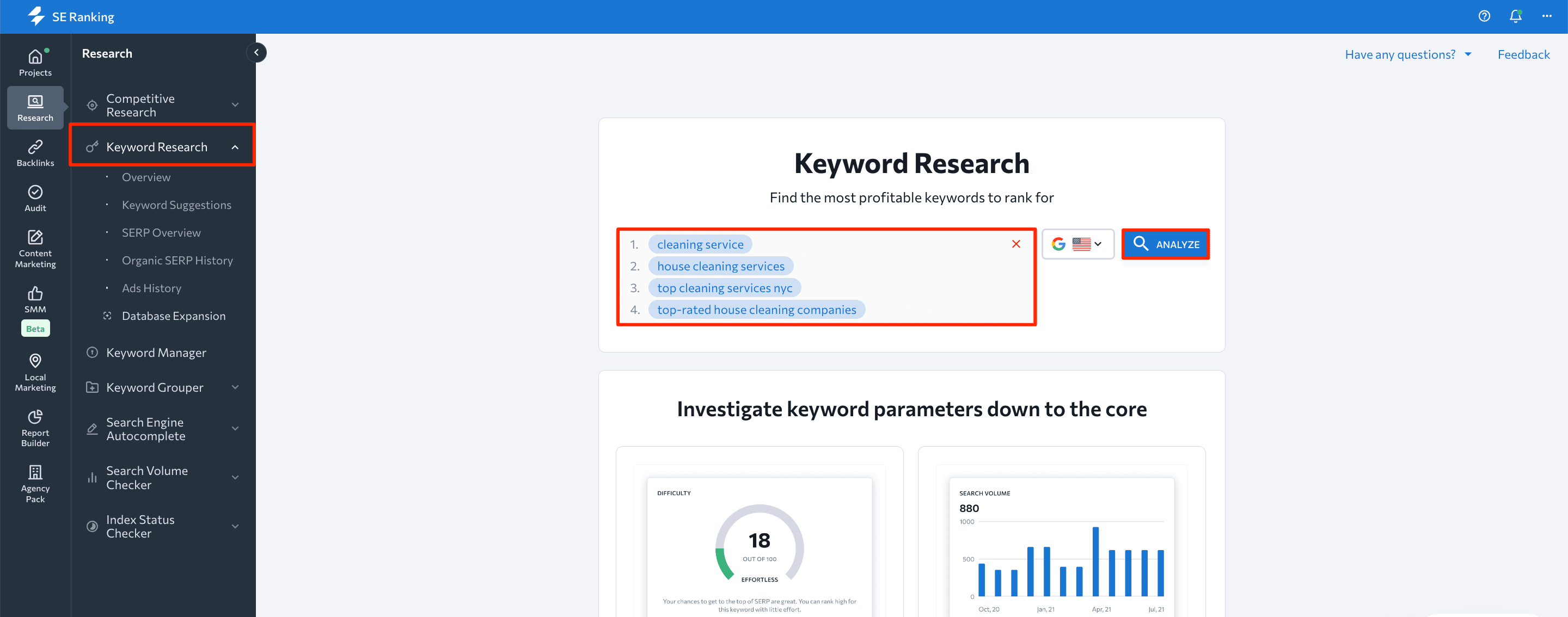
To add your current rankings to the picture, you can use GSC data. Keep in mind, though, that it only features average position data with stats being updated within 24-48 hours after collection.
Dedicated tools like SE Ranking’s Keyword Rank Tracker offer more precise data, which is updated daily. The tool also allows you to group your keywords by clusters and view rankings data per URL.
You can immediately get the total search volume and traffic forecast for each group of keywords.
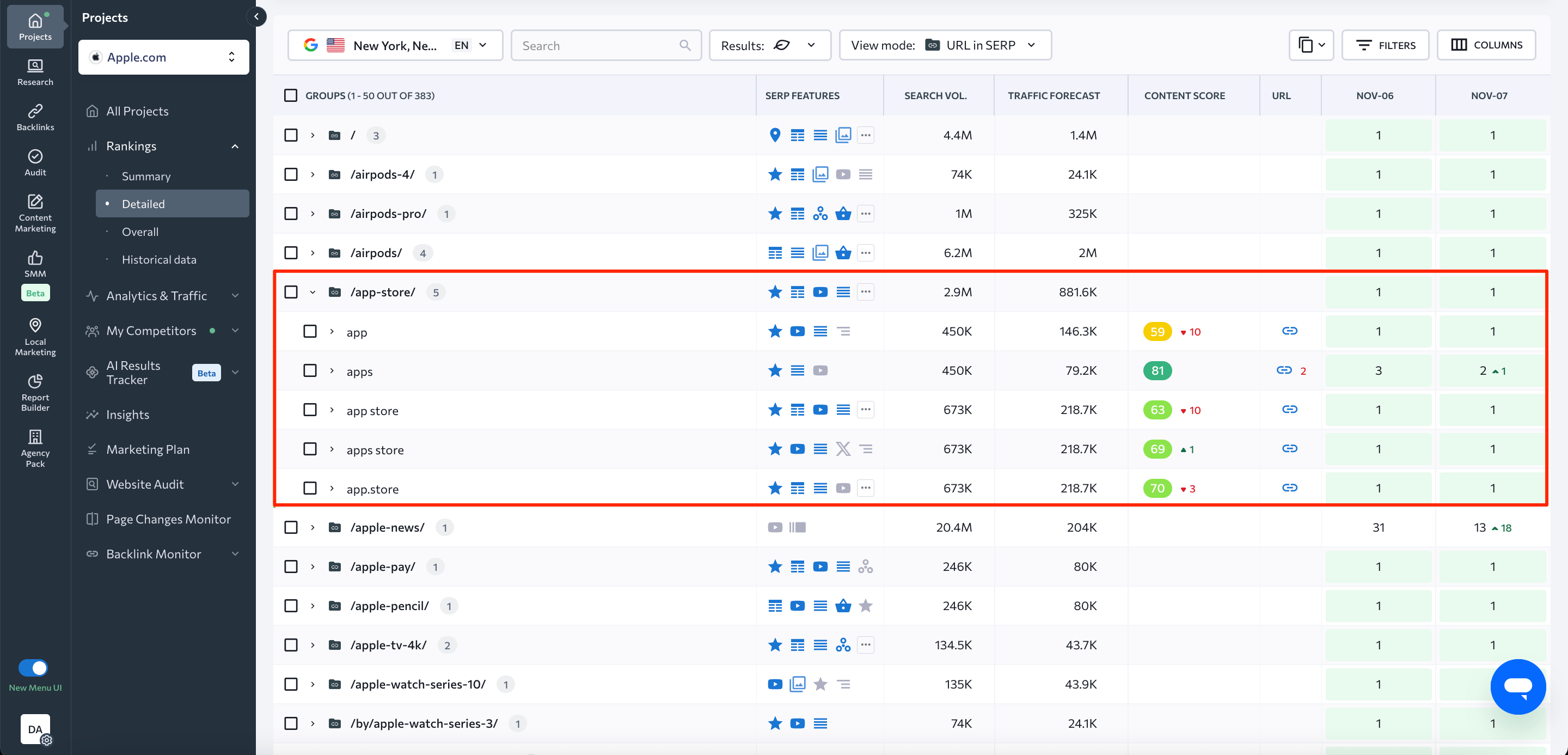
Step 2: Estimate traffic based on average CTR
Next up is to estimate traffic based on average click-through rates, as this will help you understand and forecast traffic. You can get this data on Advanced Web Rankings Organic CTR History. You can also use Google Analytics Acquisition reports if you wish to find out the CTR of your own search rankings.
To recap, the formula is as follows:
Estimated monthly traffic = Total keyword search volume * Average CTR
Let’s say one of your target pages has a total keyword search volume of 8k and its current average position is 12, but you hope to make it rank number eight on average.
Your page has commercial search intent, and according to your historical data, the expected CTR for position eight is 1%.
Therefore, your estimated monthly traffic is 8k*1% = 80 website visitors.
Many SEOs would stop here, but you can take your forecast a few steps further and calculate how your traffic then translates into leads, sales, and revenue. This would help you better understand the ROI of each keyword.
Step 3: Estimate leads based on the average conversion rate
Once you’ve found your CTR, you now need to identify how many of those who clicked on the page are actually turning into leads. Doing so will help you forecast SEO potential, understand the value of your traffic, estimate future profits, and will also help you investigate areas of improvement.
It’s not all based on guesstimates, though. You can estimate leads using the formula:
Estimated leads = Estimated organic search traffic * Average conversion rate
In the previous section, we discussed how to calculate estimated traffic, so now that we already know what the estimated organic search traffic is for a webpage, you can find out the conversion rate by using the formula:
Conversion rate = Conversion/Website visitors * 100
Let’s calculate estimated leads for the hypothetical page we discussed in the previous section. Imagine you achieved your goal of ranking it #8 on the SERP. The page’s keyword search volume, as we calculated earlier is 80, and through your own data, you figure out your conversion rate is 5%. You’ll just need to multiply 80 by 5% to find out the estimated leads you could receive (this gives us the calculation of 4 estimated leads).
Step 4: Estimate sales based on average sales data
One of the final steps in the keyword forecasting process is to find out if the leads are turning into paying customers. To do that, you’ll need to find out the estimated sales you made (or your customer-to-lead ratio).
The formula for this calculation is:
Estimated sales = Estimated number of leads * (Conversion rate/100)
So, using the same data as above, we get 40 * (5/100), which brings our total to 2.
Just to note, the number of search traffic you see for a specific keyword would be much different (and typically higher) in the real world.
Step 5: Find revenue you can obtain from the sale
Next up, you’ll need to find out how much you can earn from this sale. So, to calculate this, you’ll first need to take the price of your product into consideration and predict the quantities a typical customer might buy. You can use historical data to understand the average quantities a customer purchases.
Imagine your product costs $500 apiece, and you sell three to each customer, plus you factor in the possibility of an upsell, which would cost an additional one-time $100. You end up generating revenue of $1600 per customer using the following formula:
Revenue per customer = Sale price * Quantity + Additional revenue factors
At this stage, instead of just considering the customer as a one-time client, you can also consider their lifetime value (LTV).
For example, if you sell a SaaS product like a subscription, a typical customer may stay on as long as two years paying you monthly. However, if you sell a high-ticket product, like heavy machinery, you might not have constant, repeat customers (especially for the same product).
From our previous sections, we understood that we had two sales [40 * (5/100) = 2], so it’s time to multiply each sale by the revenue you end up making. So, 2 x 1600 = $3200. If this is your monthly revenue, you can also identify your yearly revenue by multiplying it by 12, so here, our annual revenue would be $38,400.
Step 6: Evaluate the impact of each group of keywords
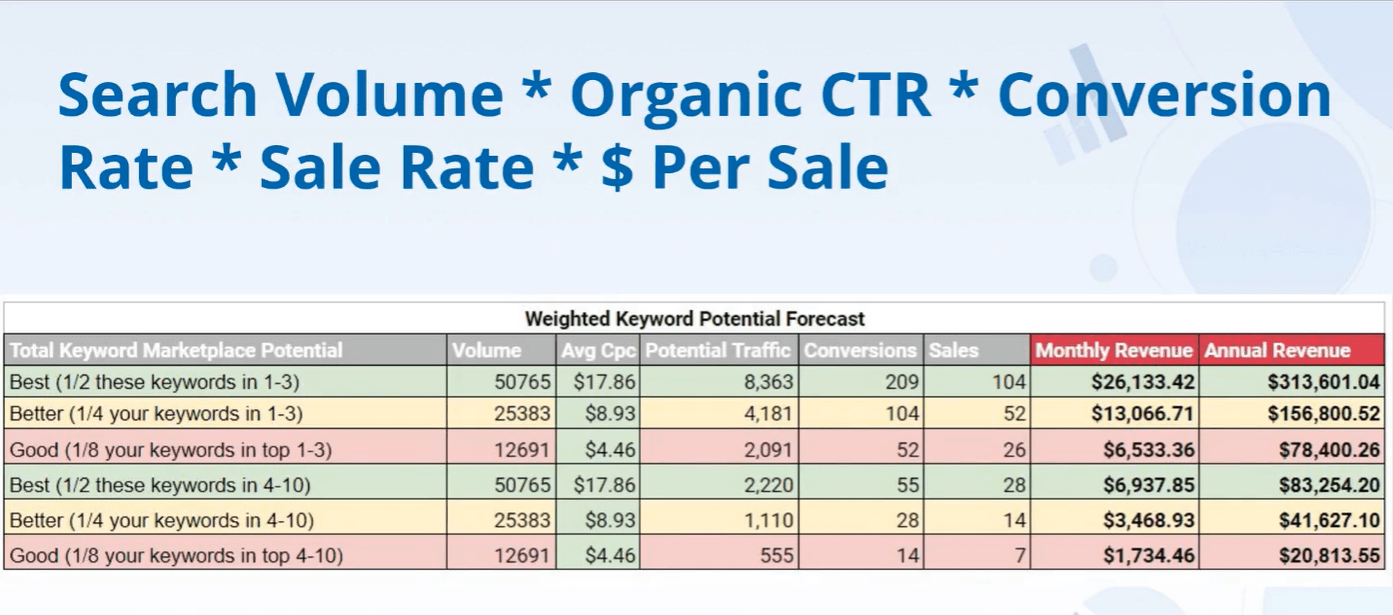
Once you have all this data on hand, all you need to do is evaluate how profitable these keywords are for you, the traffic they bring, if it makes sense to invest in them, and how to aim for a realistic increase in SERP rankings. For example, if your website ranks at position #5 on the SERP, you’ll want to aim for the second or third position in the climb toward number one.
A keyword forecasting method, which factors in the revenue each group of keywords ultimately brings, is useful if you wish to analyze the overall ROI of a keyword. It will not only tell you the number of people who have visited your website (or will visit your website), but it can also help you understand if the traffic converted into leads and sales.
2. Statistical forecasting based on historical data
Statistical forecasting relies on historical traffic data and usually applies mathematical formulas to calculate both month-over-month (MoM) and year-over-year (YoY) growth rates. Then, more formulas are applied to predict future performance based on the input data.
To perform statistical forecasting effectively, start by collecting historical traffic data from reliable sources such as Google Search Console and Google Analytics 4. These platforms offer detailed metrics, including impressions, clicks, CTR, and average position, which are essential for comprehensive analysis. Once collected, export this data into tools like Excel or Google Sheets for further preparation.
After importing the historical data into your spreadsheet, you’ll need to clean and format it for analysis. This step involves organizing the data chronologically and ensuring consistency across metrics.
Our own Organic Traffic Forecast template is designed to streamline this process by allowing you to input data from up to 16 months prior. The built-in formulas will then automatically calculate projections for up to two years ahead based on past trends.
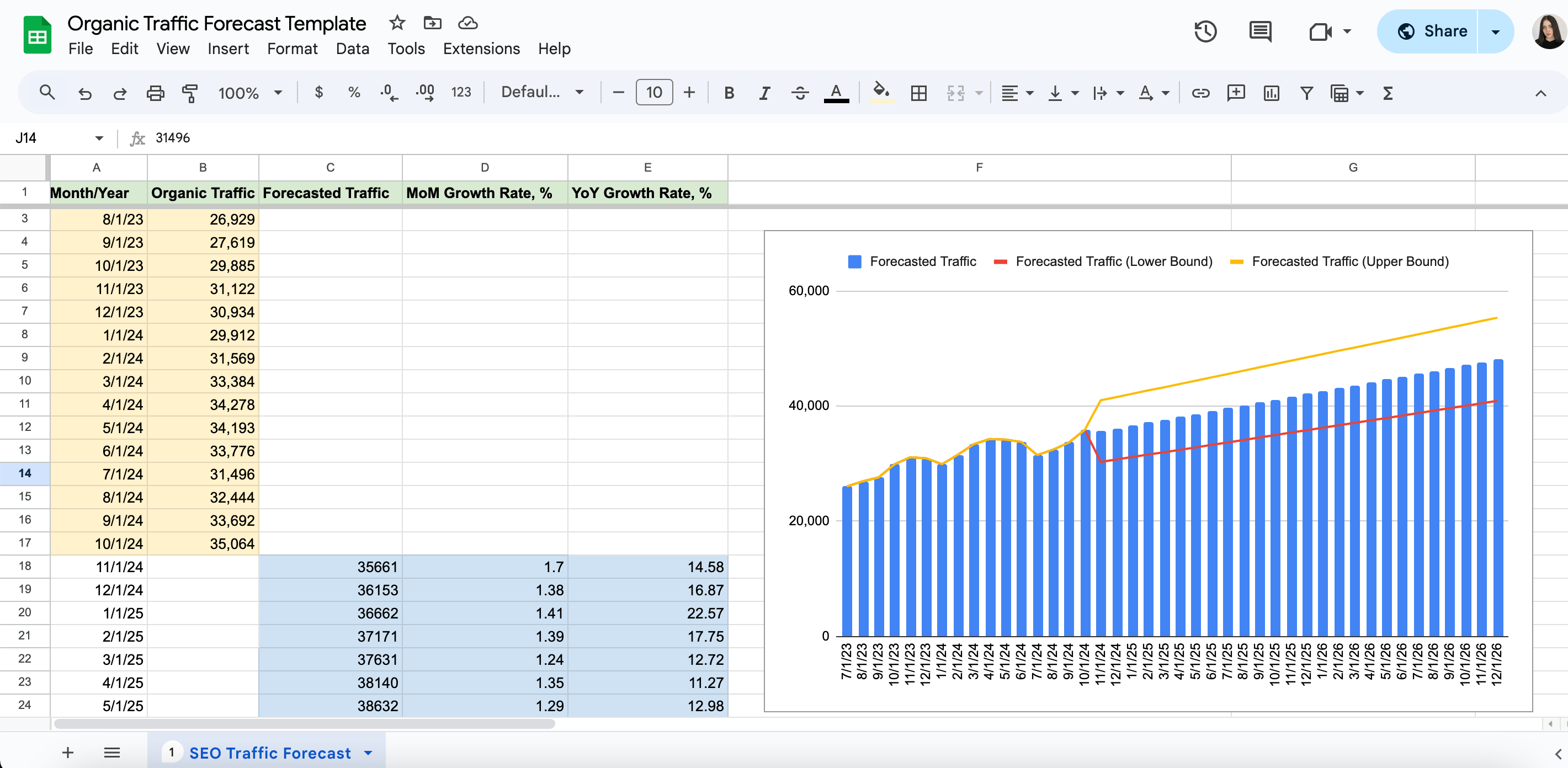
Note: The document is set to view-only mode, so you’ll need to create a copy to make any edits. The displayed ranges are just sample data; you should update them with your own specific figures.
We apply linear regression and other statistical models to create a forecast that accounts for potential variations in traffic. To make predictions more accurate and actionable, we present the forecast as an upper and lower range with a 15% margin of error. This range provides a realistic overview by incorporating natural fluctuations in search traffic that can occur due to seasonality, algorithm updates, and changes in consumer behavior.
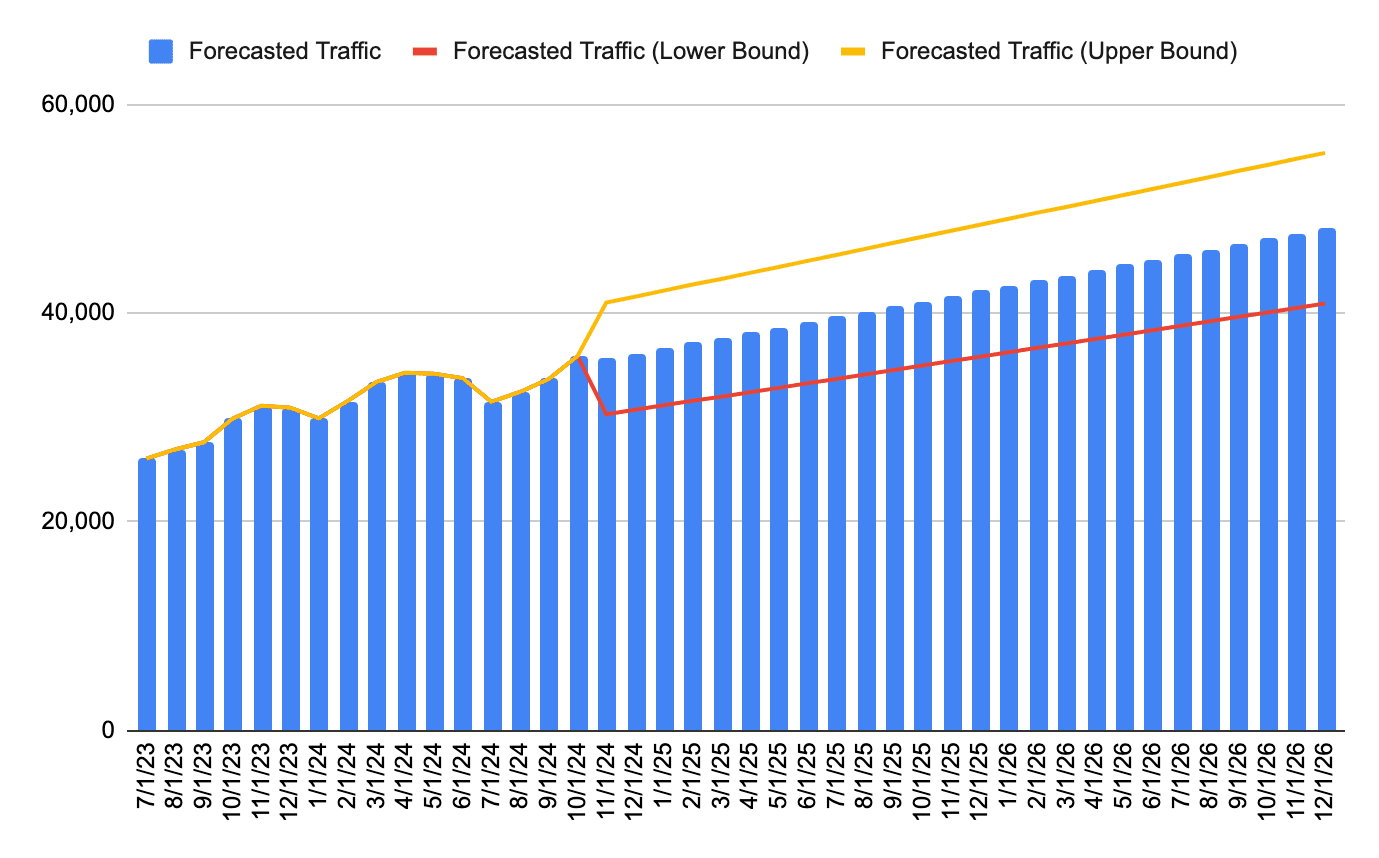
In our template, forecasting data is shown both in a table and in a chart format, which makes it easy to interpret and visualize your SEO predictions.
The statistical forecast method is especially useful if you’re someone who likes to visualize data from multiple different angles instead of reading data points and making guesstimates (plus, this is a relatively easy and free method to consider).
How to gain traffic forecast insights with SE Ranking?
SE Ranking’s traffic forecast is calculated using a comprehensive methodology that applies to both project tools and stand-alone tools within the platform.
For project tools, the traffic forecast metric is determined by combining the keyword search volume, the website’s current keyword rankings, and adjusting factors for different search engines and SERP positions.
SE Ranking’s stand-alone tools (such as Competitive and Keyword Research, Content Editor, and SERP Checker), in turn, estimate the monthly organic traffic (clicks) that a page may receive based on all keywords for which it ranks in organic search.
In any scenario, you will have access to reliable and consistent traffic forecast data. Let’s now go over where and how to find this data on the platform.
1. SEO traffic forecast by search engines and keywords
To get precise traffic forecast insights for each tracked search engine, you’ll first need to set up a project on the platform.
Add your target keywords and choose the search engines you want to track. If you’re unsure of the best keywords to use, the Keyword Research Tool can help by providing keyword suggestions and other key metrics to consider before analyzing traffic potential.
Once your project is set up, navigate to Rankings → Detailed, and select Traffic Forecast.
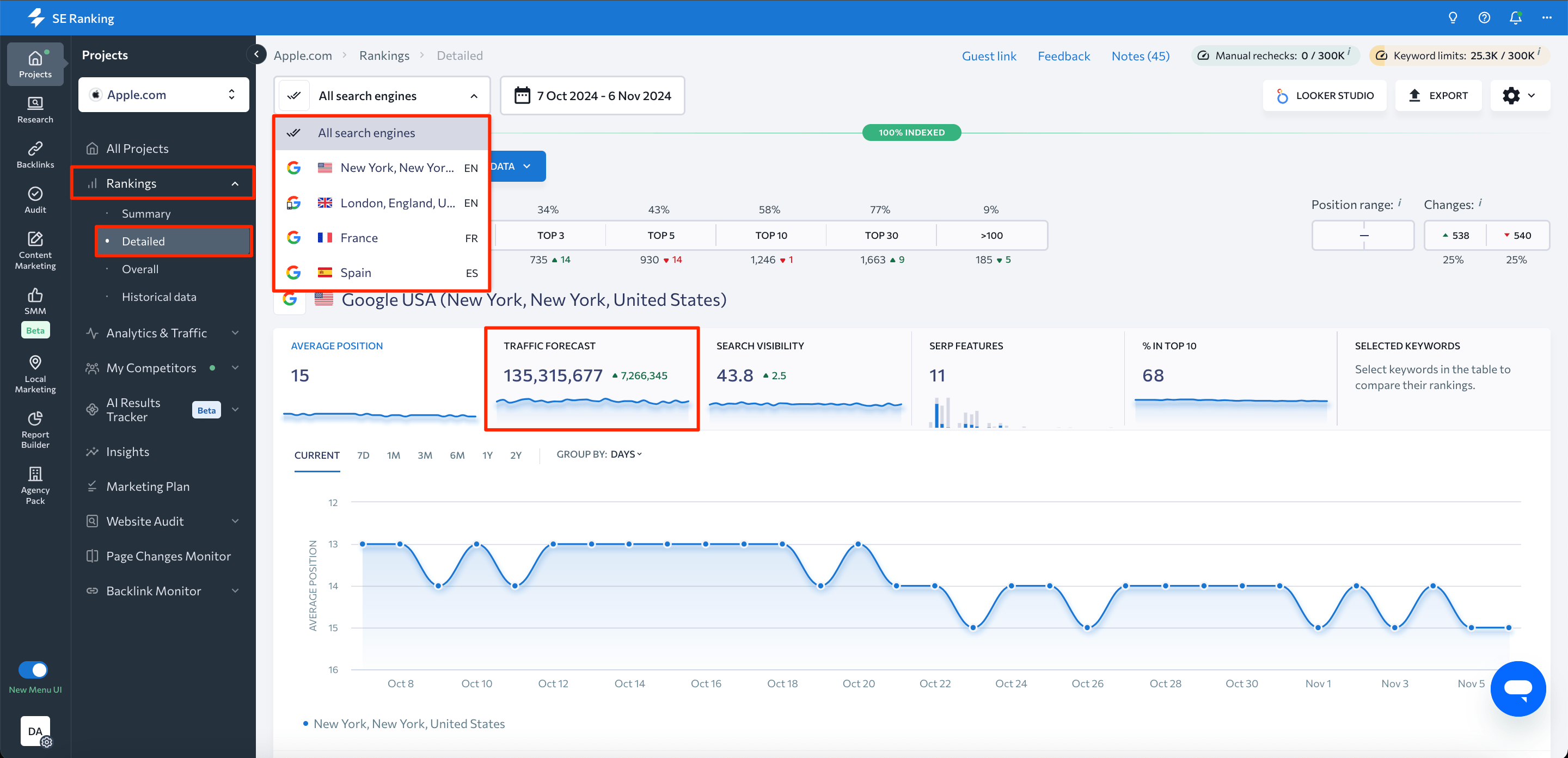
To analyze forecasts for each keyword individually, open Rankings → Detailed and find the appropriate column. If this column isn’t visible on your dashboard, add it through the column filter.
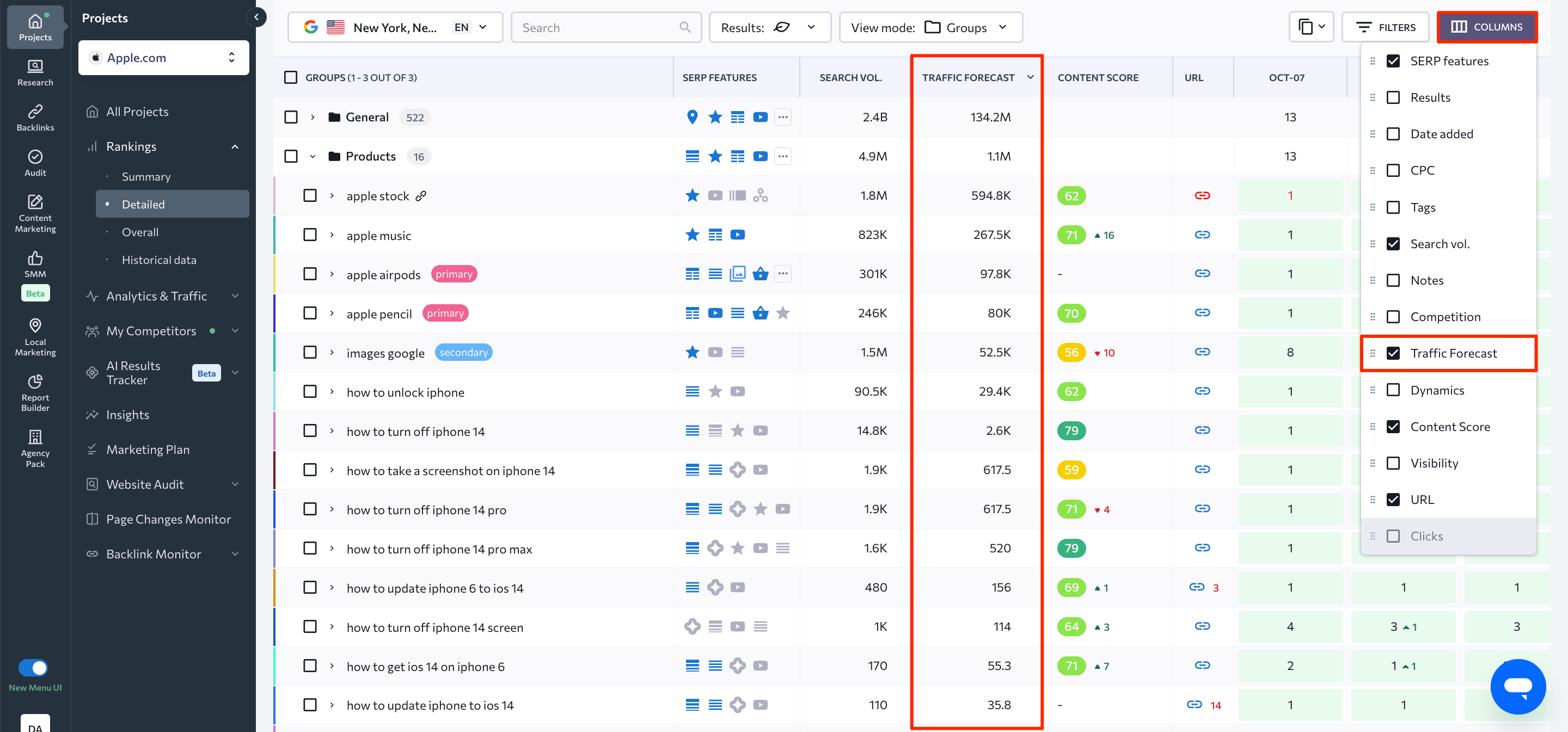
2. SEO traffic forecast insights on your competitors, their keywords, and pages
By selecting a project and navigating to the My Competitors section, you can gain valuable insights into the traffic forecasts of your direct competitors. The best part about this comparative analysis is that it allows you to benchmark your website’s traffic performance against your competitors and identify potential growth opportunities.
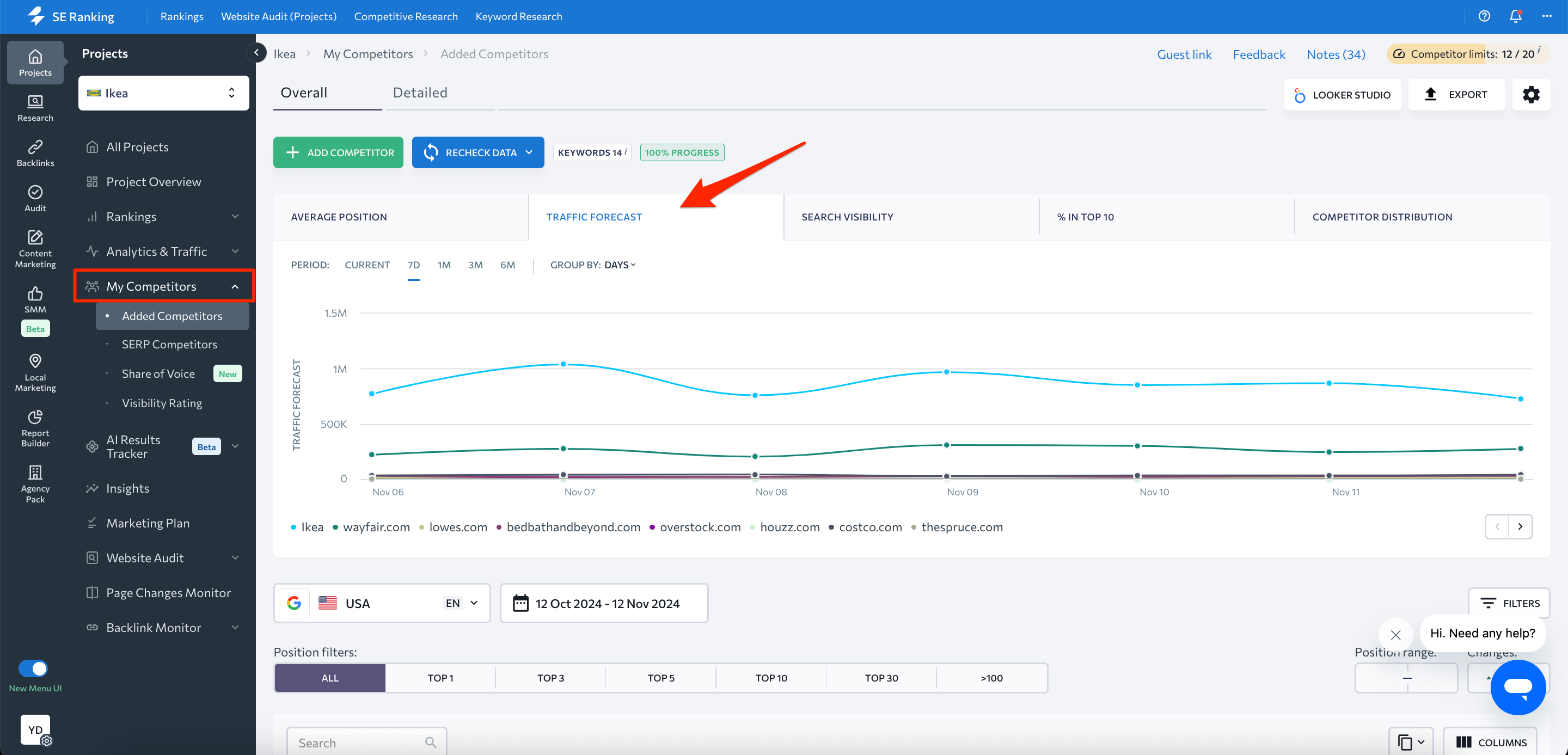
To forecast traffic for any competitor domain, you can also use the Competitive Research tool. In seconds, you’ll get an Overview dashboard displaying estimated organic traffic, traffic by country, traffic cost (for paid campaigns), and more.
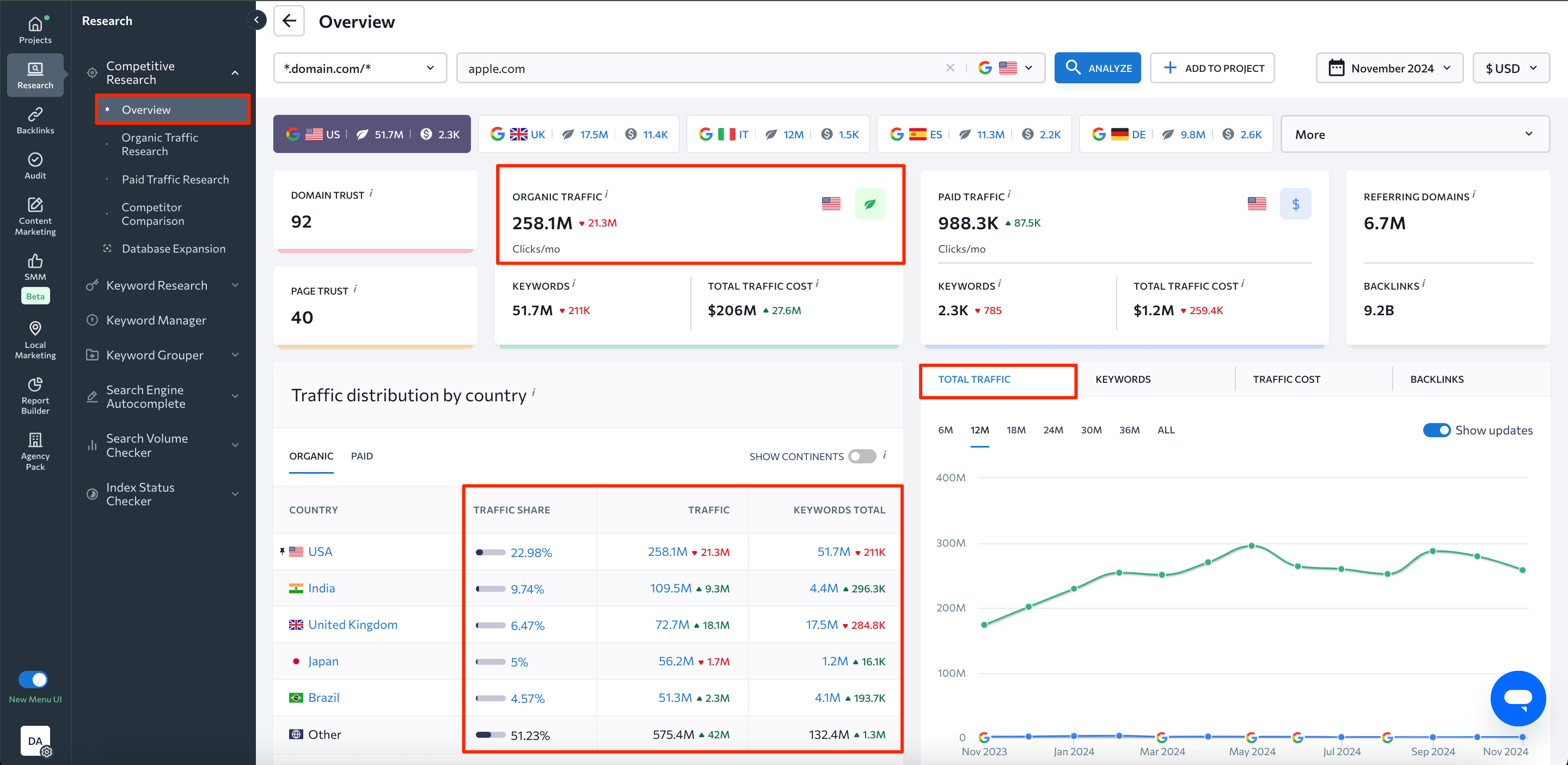
For detailed metrics like estimated clicks per keyword, competitors, countries, and pages, check out the Organic Traffic Research tab.
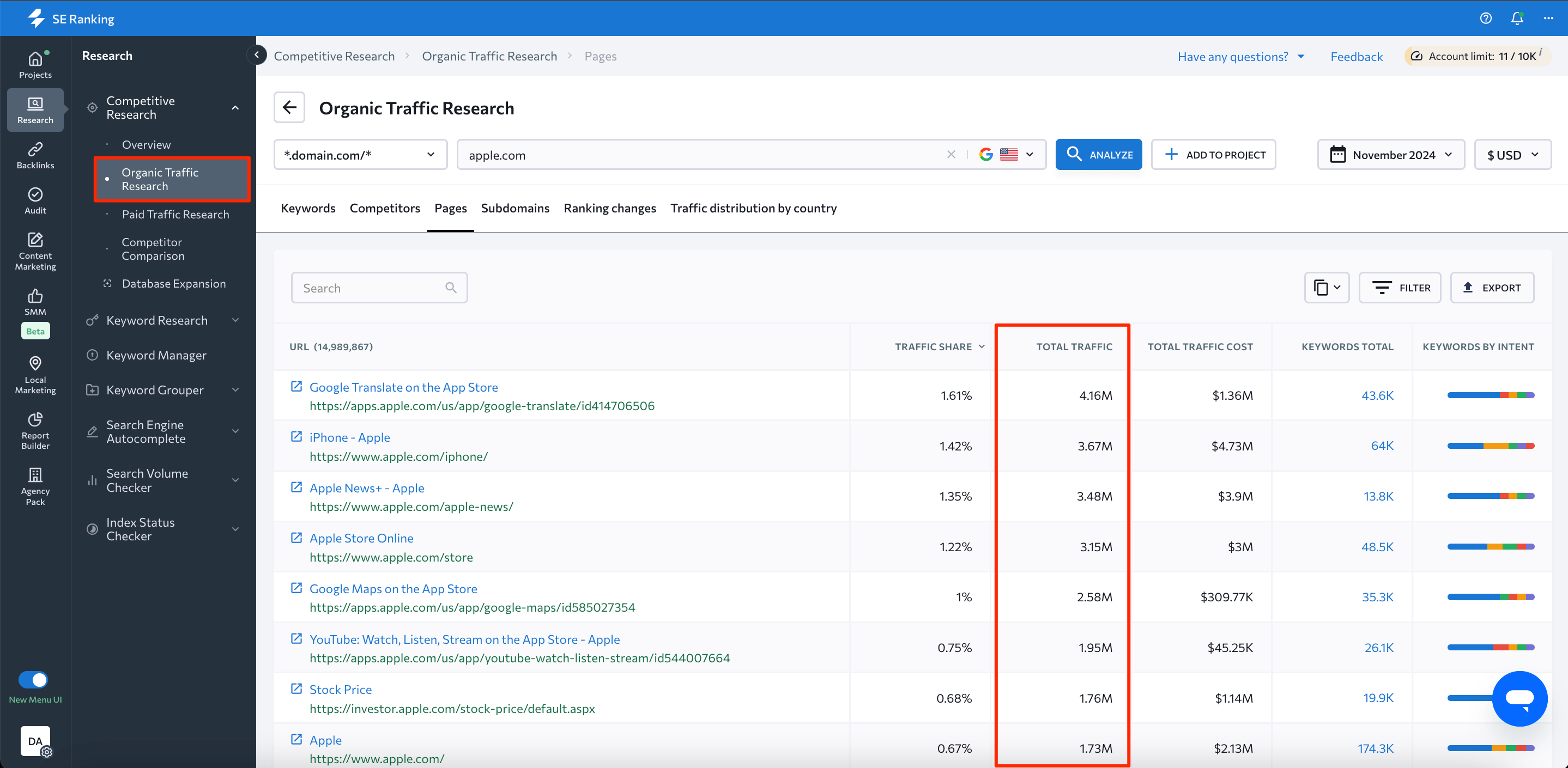
The Insights Tool also offers traffic forecast metrics for competitors. This includes:
- Competitors that recently jumped to the top 10, along with their potential traffic gains. To see more details, click View All for an expanded table.
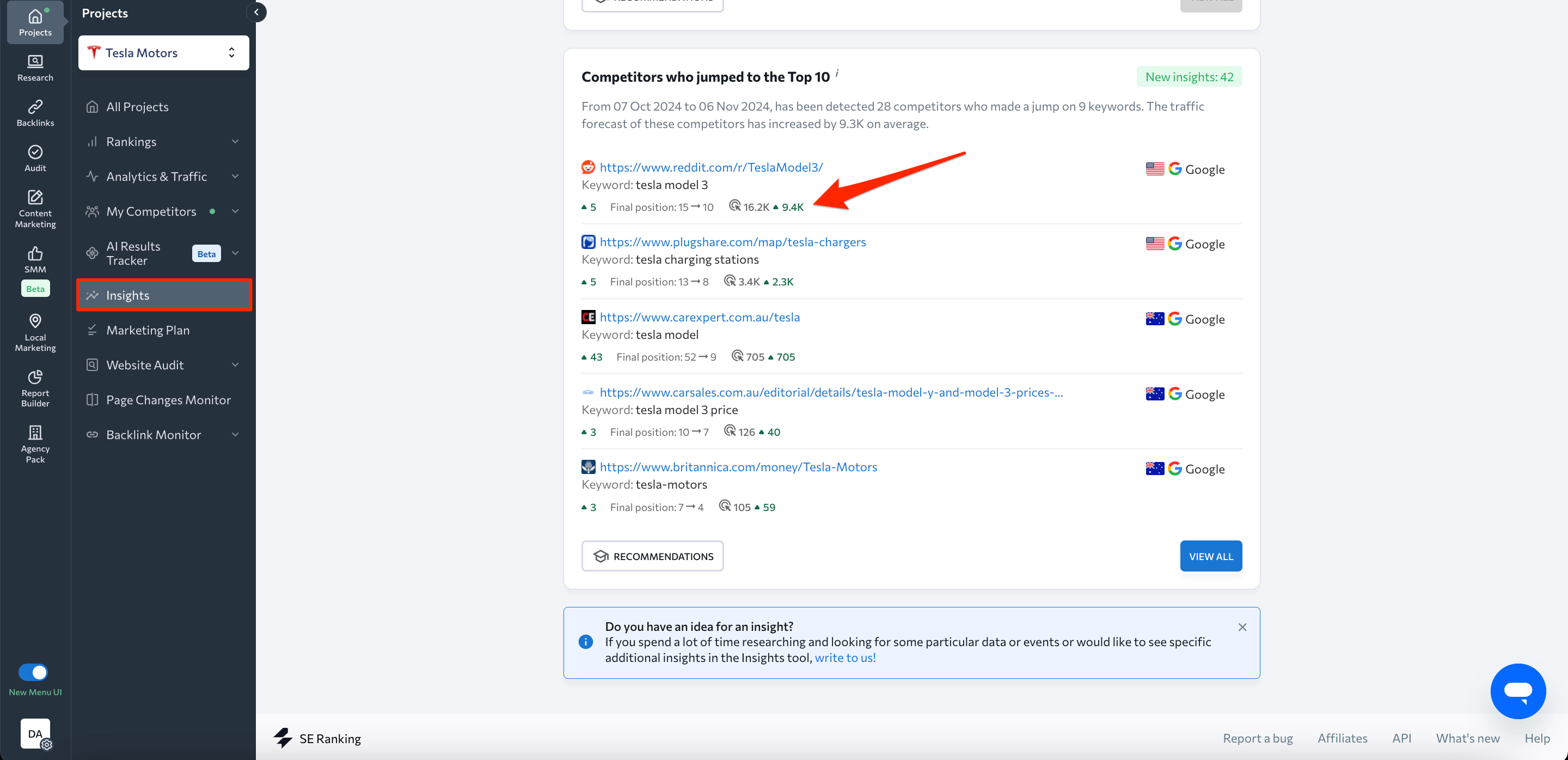
- Competitors’ new keywords that began ranking in the top 30 within the last month, along with their estimated traffic and position. By expanding these SEO reports, you can get additional details like search volume, keyword difficulty, and related URLs.
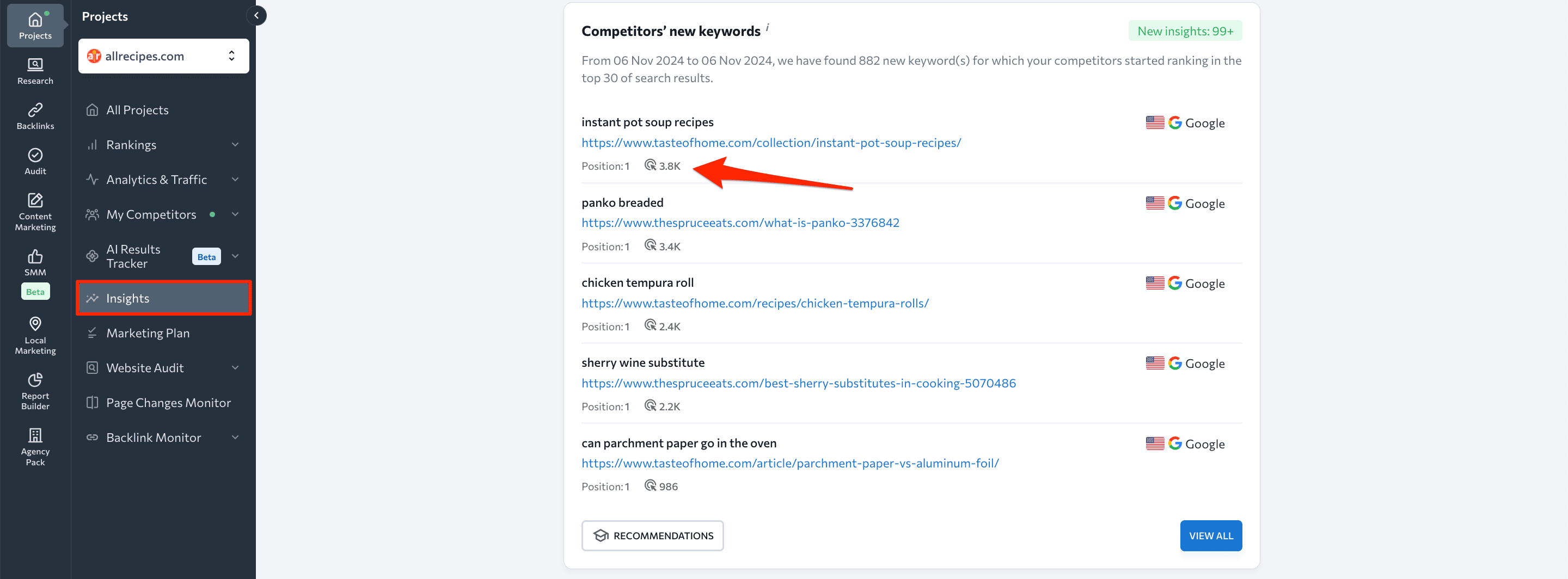
- Competitors’ new pages that have started ranking in the top 30, along with keywords and their estimated traffic.
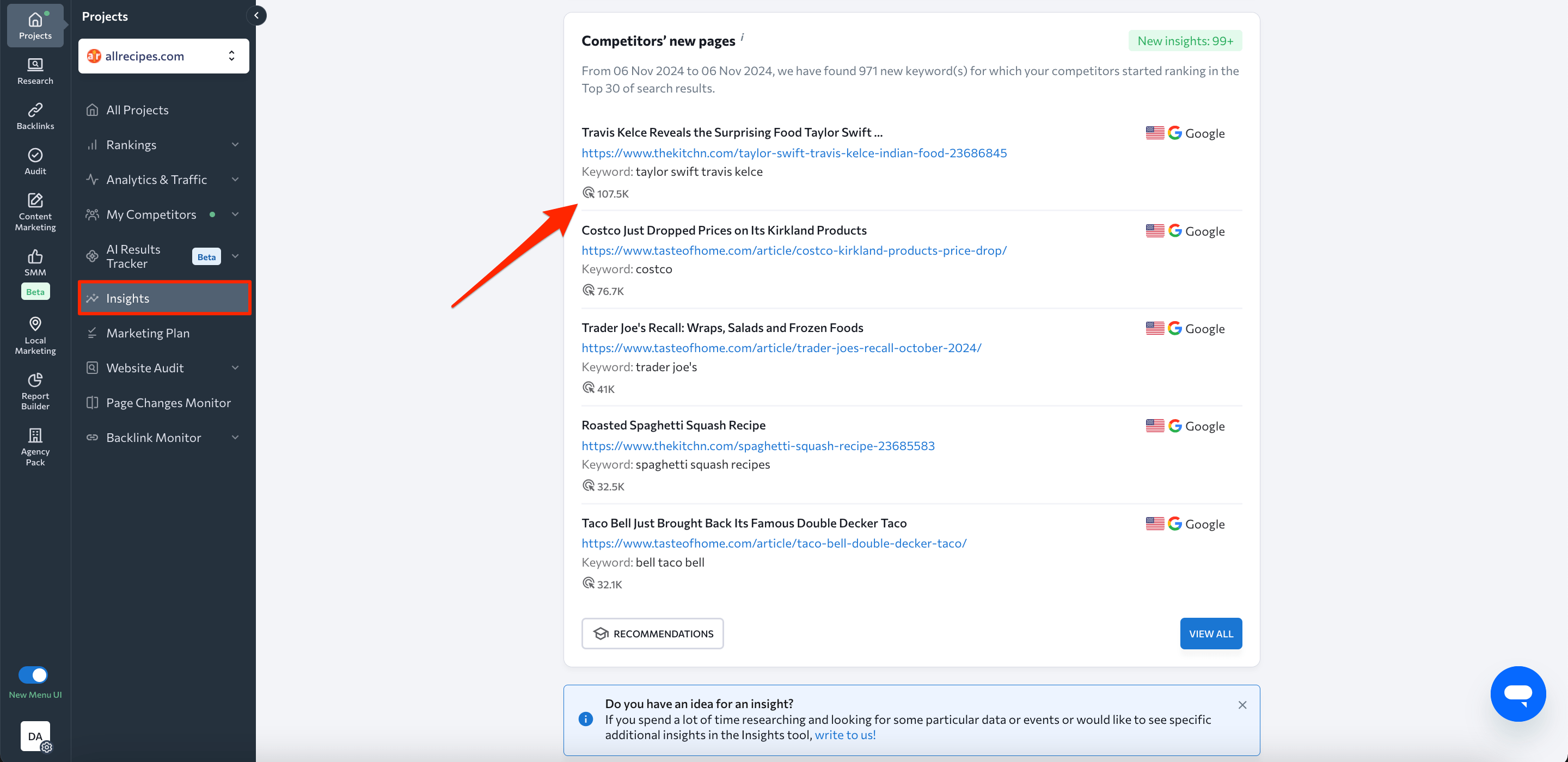
3. SEO traffic forecast for newly researched keywords
The Keyword Research tool provides keyword-based traffic estimates, accessible in:
- SERP Overview tab which lists pages ranking organically for the selected keyword.
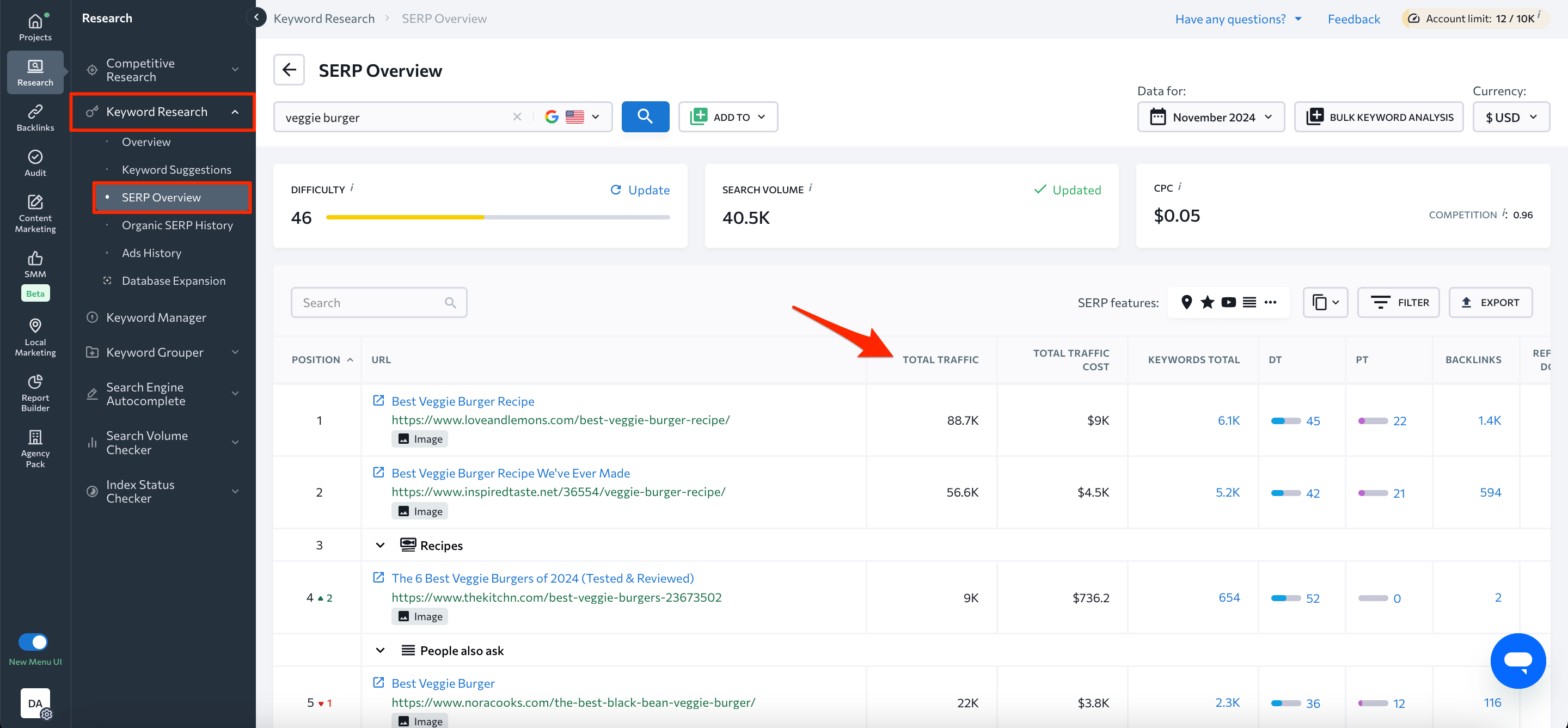
- Organic SERP History where you can compare traffic forecasts and other metrics over time.
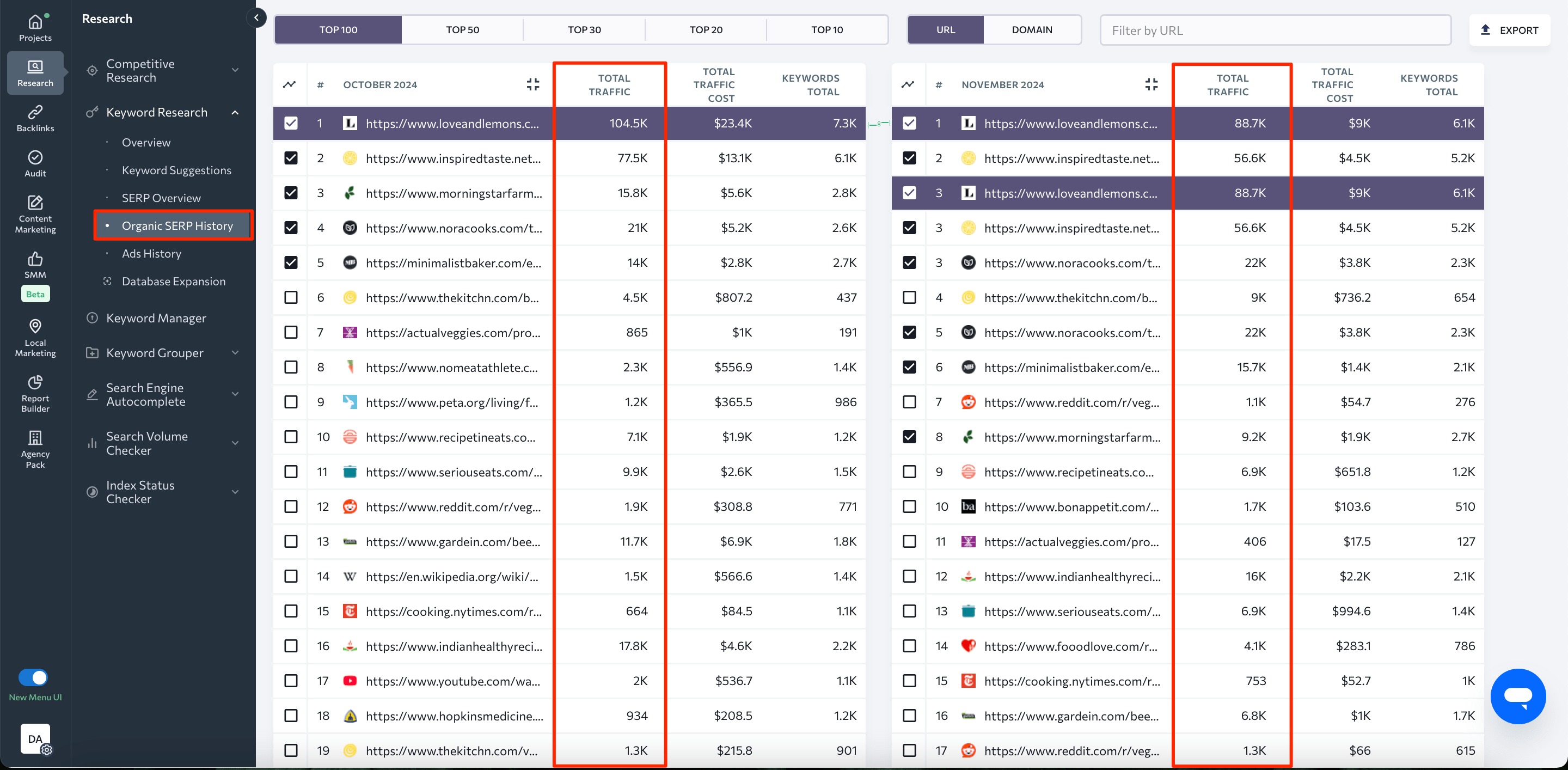
4. SEO traffic forecast for content strategy
Using SE Ranking’s Content Editor, you can build comprehensive briefs based on SERP analysis, optimize existing content pieces considering what works best for your niche, as well as generate texts from scratch with AI Writing Assistant. What’s important is that it also delivers traffic forecast insights for competitors ranking for your chosen keywords.
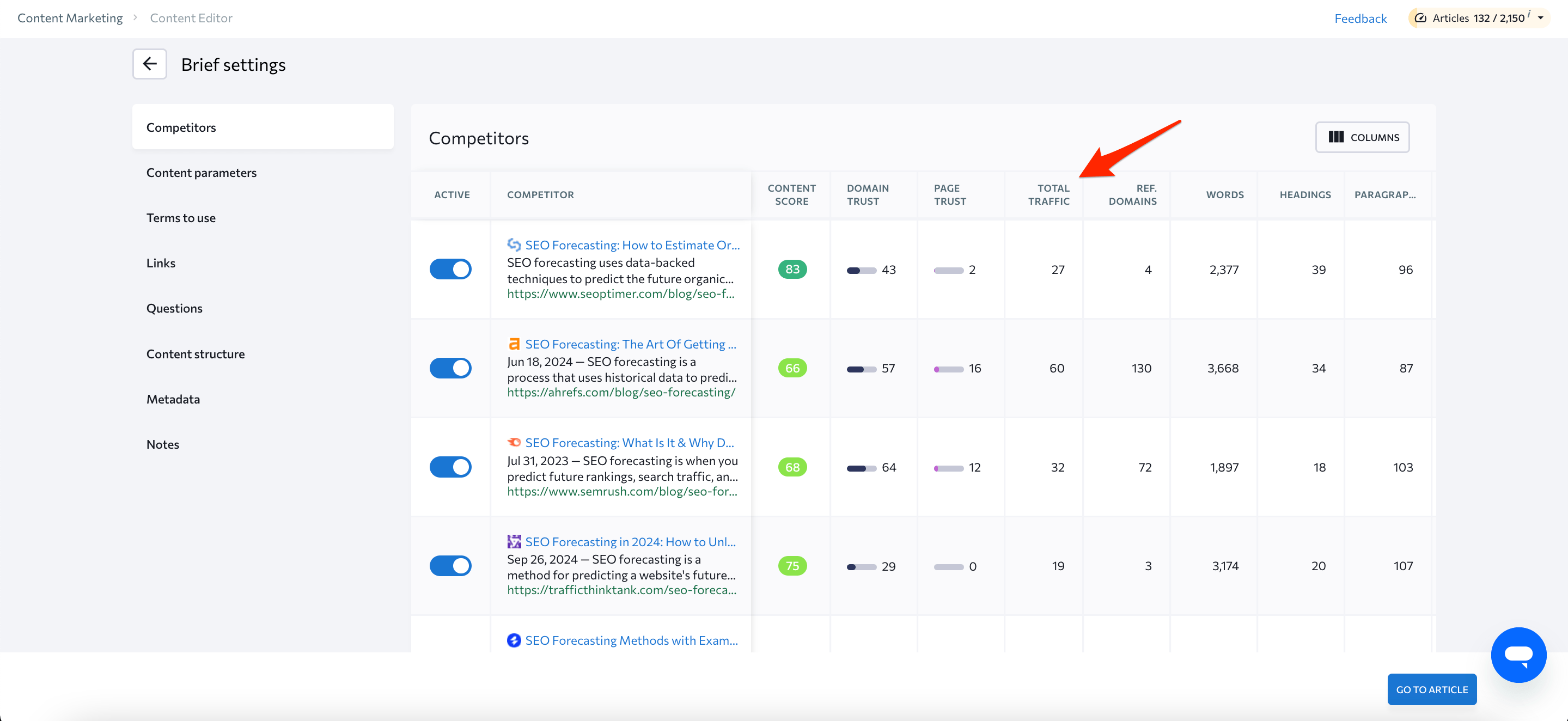
What should be done to improve SEO forecasting accuracy?
Analyze metrics for SEO forecasting
To achieve the highest possible SEO forecasting accuracy, it is important to know which metrics are necessary for the analysis and which aren’t. Your SEO forecast will be incomplete if you don’t have access to critical data like keyword search volume.
On the flip side of this coin, other metrics like clients, average order price, etc., are all directly related to business forecasting but can have little impact when trying to conduct an SEO forecast.
Another thing to consider is your data type and source.
For example, if you’re conducting SEO forecasts to predict your organic traffic based on competitor’s current traffic and how it’s trending, you will have to use third-party data, but if you’re doing it to understand how to utilize your budget based on your previous spend vs the results you achieved, you’ll have to use first-party data.
Determine your goals for SEO forecasting
Another important component of forecasting is to identify realistic SEO goals for conducting the forecast in the first place.
Ask yourself if you are doing this to get a better idea of how to utilize your budget, prioritize your work, or to get an understanding of the potential outcome of a particular keyword or keyword cluster.
Why is SEO potential forecasting important?
SEO forecasting is important because it is a data-backed methodology that helps you get a realistic outlook on how to project the search ranking of a website so you know how and where to invest your current budget and resources.
Imagine if you blindly invested all your money behind SEO into one particular keyword cluster, only to realize that it doesn’t provide any return on investment (ROI) — that would be a major dump of resources, wouldn’t it? Aside from just providing you with a handle on your budget, SEO forecasts also help you set realistic expectations for your management or clients. After all, we don’t want to create a situation where we tell our clients that we can get their website on the first page of SERP, only for that not to happen!
When is SEO forecasting not the right strategy?
Let’s look at the downsides of doing SEO forecasting (there are very few, btw!).
One of the times when you should not be doing SEO forecasting is if you’re dealing with a very tricky client who wants guaranteed results instead of estimates. In that case, SEO forecasting may not be a good idea because it can only provide estimates.
And these estimates, although data-backed, are sometimes not reliable for the trends and rapidly rising industries because they cannot guarantee what the audience’s interest, user behavior, or search intent may be in the future.
Make accurate predictions with SE Ranking
When it comes to SEO success, SE Ranking is not a tool; it’s a partner.
We have a 360-degree solution that helps agencies, freelancers, and businesses alike to achieve organic traffic growth.
For example, we have helped clients like Crux go from the 5th page on the SERP to the first page with more than 20,000 organic visitors, and did so within six months. So, if you wish to know how we can help you, too, we invite you to use our 14-day free trial to get access to rich SEO insights.

